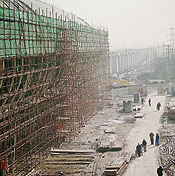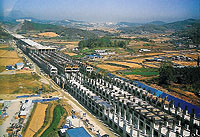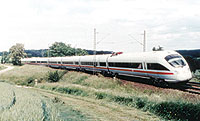 |
| TESTING TIME German maglev test facility runs trains regularly up to 400 km per hour. (Photo courtesy of Transrapid) |
A throng of waiting riders in Bremen, Germany, this spring watched the three-car train rise 10 mm off the 400-volt DC rail track, levitated by a bay of magnets that are repelled by reaction rails fastened to the underbelly of the elevated concrete guideway. Those within the cars were about to join thousands that already have paid to ride the magnetically levitated test system owned by Transrapid International, Berlin. It is a system that a growing number of U.S. advocates hope to build on domestic soil.
The train began to move, propelled by stator packs aligned along each beam. As an alternating current fed the electromagnetic traveling field, riders could feel the pull of support magnets sweeping them along. The linear motor along each 37-m section of the 30-km track turns off as the train passes, rendering collisions on the same route virtually impossible, says Robert Budell, Transrapid spokesman.
In the U.S., the pull of support and a groundswell of investments in studies by transportation firms for high-speed rail developments is gaining momentum-especially for maglev. But much still depends on whether the funding motor in Congress will run during reauthorization of TEA-21. A history of skepticisim, disputes with freight railroads over labor laws and Amtrak's financial woes, along with persistent wariness about high-speed rail, still daunt legislative efforts.
 |
| CHINA First major maglev route is taking shape in Shaghai. (Photo Lin Bin Chinapix) |
The situation "is pretty confused-looking at the moment," says Mark Dysart, president of the High-Speed Ground Transportation Association. Compounding the challenge is the factionalization of steel-wheel high-speed advocates and maglev proponents. "There is a real divide there," says Dysart. "Our formal position is that we just need to find the money to make it all available, and let the market decide."
The quiet Transrapid train-only 75 decibels loud-looped around one edge of the test track as viewers watched from a platform. On the straightaway, it began accelerating to 400 km per hour. Up ahead, track switches on steel box beams 78 m long elastically bent and locked to allow the train to cross without a break.
The huge amounts of steel involved in building this system are exactly what U.S. steel companies are eyeing. "We're extremely supportive of the concept," says John Cummings, general manager, commercial, for Bethlehem Steel Corp., Bethlehem, Pa. "It's a huge opportunity."
At a control center, three technicians watched the Bremen train on an electronic map, backup computers in tow. The train decelerated as it approached the station and the ride was over. But it is just the beginning for China, whose prime minister rode the system in mid-2000. By 2001, China committed to a 20-mile line with Transrapid technology from Shanghai to Pudong Airport-a three-year project that may vault it ahead of the U.S. as high-speed rail advocates here continue to plan, lobby and wait.
Proving high-speed rail and maglev will be cost-effective is key. "It does not help HSR here to be seen as needing constant large subsidies," says J. Christopher Brady, president of Transrapid's U.S. arm, noting that this is what has held back full-fledged U.S. governmental support. But maglev, in particular, promises a low operating and maintenance cost that will justify up-front investments, he says. "Give us a chance to build a successful system, and let's have an honest debate after that," Brady adds.
Transrapid hopes Shanghai will bring that chance. A maglev system planned for Berlin to Hamburg died on the blade of Germany's Green Party two years ago, so China's decision to build its $1.2-billion line was a shot in the arm, says Brady. The Chinese have been tight-lipped due to the risks involved with the world's first comprehensive maglev system. But officials with Shanghai Maglev Transportation Development Co. Ltd. and Transrapid say all substructure work is done and more than 500 of 2000 girders, each 24-m long and weighing 175 tons, have been fabricated. Test trains are to run next year, taking eight minutes to travel 30 km between the airport and Shanghai.
American high-speed hopes are still high. Thirty-two states are involved in designated high-speed rail corridors, says George Gavalla, high-speed rail safety administrator for the Federal Railroad Administration. Almost all of the $55 million for preconstruction of maglev systems is allocated, with $4.6 million requested in a 2002 appropriations bill, says Arnold Kupferman, FRA maglev administrator.
The maglev "pot of gold" is $950 million authorized for Baltimore or Pittsburgh, two finalists selected from seven competing U.S. regions. FRA will decide by 2003 which region gets the money, but "$1.8 billion needs to be raised beyond federal funds," says Kupferman. The agency may recommend a design-build-operate-maintain contract.
Advocates in both cities point to the wealth of engineering work that would result and boast the respective airports' support, though airlines-the parties most likely to view maglev as a competitor-have been noncommittal at best. Pittsburgh's 47-mile, four-station plan will cost about $2.8 billion, connecting airport to downtown to suburb through hilly terrain. Maglev Inc., the coalition of investors formed for the project, wants to deploy Transrapid's system. "It's the only revenue-ready technology today," says Maglev engineer Dan Disk, who has ridden the Bremen track five times. Colleague Ken Flessas adds that it would be a perfect test case: "If you can build in this topography, you can probably build maglev anywhere."
In Baltimore, the 40-mile, three-station track, also utilizing Transrapid technology, would connect Camden Yards, Baltimore-Washington International Airport and Union Station. "Eventually it would go up to Boston and down to Atlanta," says Jack Kinstlinger, project manager for KCI Technologies, a Hunt Valley, Md., firm involved in the effort. The preferred alignment has five miles of tunnels and parallels Amtrak's Northeast Corridor. It already has Acela trains traveling at 150 mph, but Baltimore's maglev proponents believe there is room for both systems.
Amtrak, the catalyst for the debate over self-sufficient rail, must curtail high-speed efforts under current budget bailout agreements. "We could be in an advisory role, or a possible operator of HSR," says spokesman Cliff Black. "But Amtrak can't pay for it-it would be like saying U.S. Air has to pay for an air traffic control system." Black claims that the Amtrak debate "has elevated the question of where we're going with any rail in the U.S."
GLOBAL UPDATE
Japan has been researching maglev since the 1970s. At the Yamanashi Maglev Test Line in April 1999, a five-car train reached 552 km per hour in a manned run. But Japan is proceeding more slowly with marketing efforts than Germany. "They are not yet willing to export their technology," says Kinstlinger.
 |
| MOMENTUM High-speed rail is moving forward fast in Korea. (Photo courtesy of KRTC) |
Korea has leaped onto the high-speed track with a $14.2-billion system based on French TGV and Japanese technology that will run between Seoul and Pusan. The $9.8-billion, 412-km first phase is set for 2004 completion with six stations, 139 km of tunnels, 112 km of bridges and 111 km of earthwork, says Young Wan Jung, an engineer with the Korea Railroad Technical Corp. KRTC president Chong-Seo Shin says that the government financed 45% of the project and backed the 55% raised in bond issues. "Unless the government is willing to provide funding, the private sector will not be willing to participate," he says.
Elevated track is growing by five 35-m-spans every day on the biggest contract for Taiwan's $15-billion high-speed railroad, to run the length of the island from Taipei to Kaohsiung. "We are really on full production," says Carlos Moller, executive director of Germany's Bilfinger + Berger Bau A.G. The Mannheim-based firm and Continental Engineering Corp., Taipei, are building nearly a third of the 244 km of elevated track on the 326-km railroad in two contracts together worth over $1 billion. The team will cast some 2,000 tapering box girders, each weighing 900 tonnes, to form 80 km of track. The private operator, Taiwan High Speed Rail Corp., finished awarding 12 engineering contracts last year, and is on course for completion in late 2004. "Bullet" trains from Japan are slated to run in October 2005. Click here for Graphic
The Dutch government is pushing its first high-speed line from near Amsterdam to the Belgian border and is developing long-term plans for a northern route, possibly using maglev. Due for completion by 2015, the 190-km line would run northeast from Schiphol airport to Groningen and cost an estimated $6.5 billion just for infrastructure. Studies likely will last four years, says a spokeswoman for the Dutch transportation ministry.
Construction already is under way in a series of design-build contracts with international consortia for the $7-billion, 100-km route to Belgium. Paris-based Bouygues S.A. leads a group using one of the world's biggest TBMs-over 15-m-dia-for the Green Heart tunnel. A consortium led by U.S.-owned Fluor Infrastructure B.V. last year closed a 25-year contract worth some $1.2 billion to finance, build and maintain the line's operating equipment from the track upward. The line is due to start service in 2006.
France is setting out on a new vast project, from Paris east to the German border. Since March, the government's rail infrastructure owner, RÈseau FerrÈ de France, has awarded contracts covering some 60% of the first phase of construction. Remaining contracts are due by next March, says spokesman Thierry Jankowski. For the first time, the owner outsourced engineering and project management to private design firms in five packages. Work is focusing on the first 300 km from Paris to Baudrecourt. The remaining 100 km to Strasbourg has yet to win political support. Public-sector interests, including the European Union, agreed to contribute over $3 billion needed for this phase, but RÈseau FerrÈ recently announced 10% more in funds and another year of construction would be needed.
On the U.K.'s $8-billion Channel Tunnel Rail Link, the final phase of tunneling began July 11 with the launch of a machine under the River Thames. The 8.15-m-dia pressurized slurry TBM will drive 2.5 km from twin tunnels at Swanscombe. The remaining 20 km of the underground link to London will be done under other contracts. With the second phase 20% built, the project is on course to completion in 2007, says owner London-based London & Continental Railways Ltd. LCR packaged construction in two phases to ease financing, which involves extensive government loan guarantees. The southern 74-km first phase, costing $2.9-billion and begun in October 1998, is due to begin operations next year.
 |
| LOOKING UP Europen firms are working on high-speed rail in Taiwan. (Photo courtesy of Bilfinger+Berger) |
U.S. HOPES
Domestically, high-speed rail has arguments in its favor that it didn't a year ago. "The events of 9/11 caused people to realize that we have to look at new modes of transportation," says Sarah L. Catz, attorney and policy specialist with law firm Nossaman Gunther Knox & Elliott, San Francisco. Adds Fred Gurney, president of Pittsburgh's Maglev Inc: "We do not think maglev will replace cars or planes. We just want to make a niche." Click here for Map
Higher-speed rail, not maglev, is the humbler goal of many U.S. regions. Virginia is spending $65 million on infrastructure improvements for such a goal, notes Alan Tobias, director of the state's railroad agency. "What we call HSR, we assume is 110 mph," he says. Tom Smithberger, national rail director for Omaha-based HDR Inc., adds that 11 high-speed rail corridors in the southeast are under planning.
At Old Dominion University, the first U.S. maglev project is nearing completion. A single vehicle will shuttle along a 1-mile elevated guideway at 40 mph. All design, development, testing and commissioning cost $22 million, says Tony Gee, head of Tony Gee International, Edgewater, Fla., engineer for sponsor American Maglev Technology Inc. The system will go into operation by fall. AMT, boosted by investments from Lockheed Martin and Dominion Virgina Power, believes it can build future systems for $19 million per mile, not the average of $60 million usually associated with high-speed rail, says President Tony Morris.
In the Midwest, initiatives focus on a hub-and-spoke system of routes emanating from Chicago. Planners identified three priority corridors extending to Detroit, St. Louis and Milwaukee. In anticipation, the city of Chicago has hired the local office of TranSystems Corp. to prepare preliminary designs for a three-deck subsurface transfer station providing intermodal links. Click here for Map
The Michigan Dept. of Transportation, Amtrak, FRA and General Electric Co. installed a train-control system that uses radio communications and global positioning to enable speeds of 90 mph along a 45-mile stretch in southwest Michigan. In Illinois, Union Pacific crews upgraded portions of the Chicago-St. Louis track to allow speeds of up to 110 mph. Illinois also is working on a positive train control system for the corridor, says Randall Wade, chairman of the Midwest Regional Rail Initiative steering committee. MRRI is a nine-state high-speed-rail planning group, assisted by Transportation Economics & Management Systems Inc., Frederick, Md., and HNTB Corp., Kansas City.
 |
| STEEL WHEELS Competition will bring out the best in competing high-speed technologies. (Photo courtesy of Siemans Transportation Systems Inc.) |
HNTB also is general engineering consultant for the Florida High-Speed Rail Authority on an Orlando-Tampa link. Despite the nixing of ambitious high-speed rail efforts there by Gov. Jeb Bush (R) in 1999, a new study arose out of a referendum passed by voters mandating a HSR system to be under construction by 2003, notes HNTB project manager Charlie Quandel.
By mid-2003 Sacramento-based California High-Speed Rail Authority will complete environmental documents for a 700-mile, 200-mph system linking northern and southern California, says Mehdi Morshed, the agency's executive director. Cost estimates reach $33 billion, but a proposed bond issue would provide $9 billion for 2.5-hour service between Los Angeles and San Francisco by 2008. Buildout for the entire system could take 17 years, but some sections could be built sooner, says Kip Field, assistant vice president for lead program manager Parsons Brinckerhoff Inc.'s regional office in Orange, Calif.
Maglev is not an option in portions with no room for new dedicated alignment, says Field. And the critical north-south connection faces daunting challenges, especially tunneling in mountainous earthquake-prone country, he adds. But contractors at a workshop sponsored by the authority last year generally agreed that it is feasible, Field says. Another challenge is developing railcars light enough to maintain 200-mph-plus speeds yet sturdy enough to meet federal crash-safety requirements.
One of the U.S.'s best bets may be a 272-mile maglev link on the Las Vegas-Southern California corridor, a plan strongly touted by U.S. Rep. Don Young, R-Alaska. The California-Nevada Super Speed Train Commission envisions a 90-minute trip on 300-mph trains at an estimated $7 billion. The early choice is to build the project in two chunks-a 163-mile leg between Las Vegas and Barstow and an 89-mile Barstow-to-Anaheim leg, says Richann Johnson, a senior project development officer for Las Vegas and the commission's executive assistant. Construction could start by mid-decade, says Johnson. The route uses the Interstate 15 corridor, and "we believe we can get that right-of- way from both states at a minimum cost," he says.
Observers acknowledge that high-speed rail still has an uphill climb. Identifying and securing funding "is the first and foremost challenge," says Morshed. But Catz, noting a recently completed $1-billion widening of I-5 in Orange County, Calif., says, "For a couple of billion, you can have an operable segment of a whole new technology."

Post a comment to this article
Report Abusive Comment